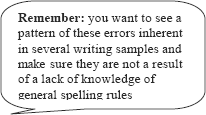Together you want to determine:
- If the learner is able to balance the mechanics of the text with the meaning of the text
- If the learner understands the relevance and importance of the stages in the process of writing; in particular the planning, organizing and editing phases
- If the learner has or is aware of his or her use of strategies for monitoring the writing process
The actual writing sample should be assessed in the areas of content, conventions, syntax and vocabulary.
- Content: is there a beginning, middle and end, and is the content connected to the topic?
- Conventions: spelling, punctuation, grammar, use of capitals
- Syntax: sentence formats
- Vocabulary: is it written at the appropriate level? Is it varied and unique?
Indicators of potential learning disabilities
Overall you are observing for any discrepancy in skills and/or patterns of errors.
For example, a person who has potential visual processing challenges may often show a
 difference between his/her oral and writing communication, with the former being stronger.
difference between his/her oral and writing communication, with the former being stronger.

What to look for in writing samples:
- Letter reversals
- Spelling a word in several different ways on the same page
- Persistent problems with spelling, even with easy and common words
- Good days and bad days with spelling
- Difficulty getting ideas down on paper despite strong verbal communication and ability to spell
- Persistent problems with sentence structure (run on sentences and incomplete sentences), punctuation and/or organization of written work, not due to a lack of instruction or previous experiences
- Writes slowly, letter sizes vary, limited space between words
- Difficulty in seeing his/her own errors